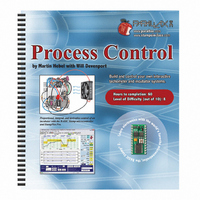122-28176 Parallax Inc, 122-28176 Datasheet - Page 280

122-28176
Manufacturer Part Number
122-28176
Description
GUIDE STUDENT PROCESS CONTROL
Manufacturer
Parallax Inc
Specifications of 122-28176
Accessory Type
Manual
Product
Microcontroller Accessories
Lead Free Status / RoHS Status
Contains lead / RoHS non-compliant
For Use With/related Products
Propeller Education (PE) Kit
Lead Free Status / RoHS Status
Lead free / RoHS Compliant, Contains lead / RoHS non-compliant
- Current page: 280 of 330
- Download datasheet (11Mb)
In an actual system, just as with the automobile example, the derivative output changes in
a direction and magnitude to counter the error. Acting on the window blinds, as the
sensor suddenly lightened, the output would quickly move the motor with a motion
relative to the change.
Just as with proportional and integral, we can adjust the amount of force applied by
derivative by setting the gain (K
though.
In the examples up until now, the output swung both positive and negative for control of
the system. In most cases, the output will only be in one direction. Consider the car
example. On a level highway, the pedal will be in a position to supply sufficient energy
to keep the car at the setpoint speed. The pedal is adjusted up or down from this center
position to control the speed. In the floating ball example, the electro-magnet will have a
set amount of drive (preferable 50%) when the ball is correctly in the beam. As it rises,
drive will cut back; as it falls, drive will increase.
Bias is used to provide a midpoint drive that, with good engineering, should maintain a
stable system at the setpoint under normal conditions. We will test adding bias to our
calculations and controlling the system with that as the midpoint.
Adding Bias
√
√
√
CalcDeriv:
RETURN
Modify the program to multiply
1.0 second.
Try to hold your hand so that the output does not exceed a value of +/− 400 for
20 seconds.
Even leaving the sensor totally uncovered, the measurement fluctuates due to
noise. Note the amount of output change simply based on the noise.
DEBUG "!O txtLE=", SDEC LastError,CR
ErrorChange= Error - LastError
SignBit = ErrorChange.BIT15
Deriv = ABS(ErrorChange)/Samples * 4
IF SignBit = 1 THEN Deriv = Deriv * -1 ' Re-apply sign
LastError = Error
D
). Too much gain can cause erratic control of a system,
Deriv
by a gain of 10, and set a sample time of
' Calculate derivative output
' Update SP with last error
' Calculate dE
' Save sign, 1 = negative
' Divide by dt
' Save Lat error for this eval
Related parts for 122-28176
Image
Part Number
Description
Manufacturer
Datasheet
Request
R

Part Number:
Description:
MANUAL FOR SUMOBOT
Manufacturer:
Parallax Inc
Datasheet:

Part Number:
Description:
GUIDE STUDENT SMART SENSORS
Manufacturer:
Parallax Inc
Datasheet:

Part Number:
Description:
MANUAL PROPELLER
Manufacturer:
Parallax Inc
Datasheet:

Part Number:
Description:
LEAD WIRES FLYING CABLE III/IV
Manufacturer:
Xilinx Inc
Datasheet:

Part Number:
Description:
BOARD ADAPTER AND FLY LEADS
Manufacturer:
Xilinx Inc
Datasheet:

Part Number:
Description:
PLATFORM CABLE USB II
Manufacturer:
Xilinx Inc
Datasheet:

Part Number:
Description:
KIT STARTER COOLRUNNER-II BUNDLE
Manufacturer:
Xilinx Inc
Datasheet:

Part Number:
Description:
Microcontroller Modules & Accessories DISCONTINUED BY PARALLAX
Manufacturer:
Parallax Inc

Part Number:
Description:
Microcontroller Modules & Accessories DISCONTINUED BY PARALLAX
Manufacturer:
Parallax Inc

Part Number:
Description:
BOOK UNDERSTANDING SIGNALS
Manufacturer:
Parallax Inc
Datasheet:

Part Number:
Description:
BOARD EXPERIMENT+LCD NX-1000
Manufacturer:
Parallax Inc
Datasheet:

Part Number:
Description:
IC MCU 2K FLASH 50MHZ SO-18
Manufacturer:
Parallax Inc
Datasheet:












